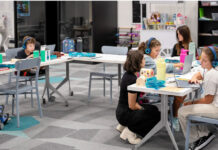
Flipped learning goes beyond innovation. It is a necessity to reach students who struggle with the traditional model based on learning in class.
“The more difficult work happens in individual papers, projects and homework outside of class, where access to help is much more limited. And while professors may still be available outside of class via office hours or other modes of contact, only traditionally “good” students tend to seek out those resources,” said Professor Robert Talbert during a recent workshop at The George Washington University.
“We set students up for failure in some ways,” said Dr. Talbert, a math professor at Grand Valley State University. “They’re encountering the most difficult material at the moment when they’re most alone…and on the flip side we’re giving them the simplest stuff when we’re most accessible.”
In a “flipped” model, by contrast, students’ initial contact with material takes place before class, freeing up classroom time for active learning. The “classroom” may also be virtual, as in an online course. Students might watch a videotaped lecture, read a guide to the material and complete worksheets before any teacher introduces them.
Preliminary studies suggest impressive results, like increased student engagement and improved pass rates, in classes that flip their curriculum.
“Flipping” is a response to a basic structural problem of traditional teaching models, in which students generally do the easiest work—learning vocabulary, new ideas and basic principles—in class, where they have the most access to help from peers and teachers.
In general, the flipped model is a win-win for students and teachers, Dr. Talbert said. “Students will prepare if they’re given an activity that makes it worth their while,” he said. “And we should only give assignments that we want to grade.”
“I firmly believe that higher education has the power to transform everything and everybody it touches for good—but I feel that higher education today isn’t living up to its potential,” he said. “So making simple changes will do a lot of work to get higher education back to its roots.”

 En Español
En Español










![OpenAI Released Apps that Work Inside ChatGPT and an SDK [Video]](https://iblnews.org/wp-content/uploads/2025/10/openaieventday-218x150.jpg)









